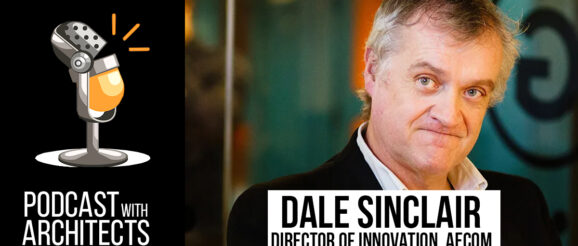Podcast with Architects: Dale Sinclair, Director of Innovation, Aecom (Spotify) – RTF | Rethinking The Future

London Festival of Architecture (LFA) celebrates architects and architecture in the city of London for the entire month of June since the last 15 years. The Podcast show – Architecture Masters extends into this carnival for architecture where a series of conversations emerge to the audience by the leading designers in the industry. These spectacular individuals shape the cities within the scope of the profession and create an impact that establishes an edge to creativity, building and design that stands to fascinate by its material, spatial planning, beauty and functionality. Thus, a program for people around the world to tune in and understand the strategies and stories of the works done by architects in London city.
The programme begins with an introduction to Dale Sinclair, Director of Innovation, Aecom; a global infrastructure consultancy where the works focus on the future of architecture and the profession of it. Before this, Dale worked at the RIBA and held a chair at the committee overhauling the RIBA’s Plan of Work in 2013 that required a change since the introduction of it in 1963, where the documents indicate the formal stages of designing, procuring and construction of buildings. He wrote books on the RIBA Plan of Work along including The Lead Designers Handbook and Leading the Team: An Architects Guide to Design Management.
The programme begins with an introduction to Dale Sinclair, Director of Innovation, Aecom; a global infrastructure consultancy where the works focus on the future of architecture and the profession of it. Before this, Dale worked at the RIBA and held a chair at the committee overhauling the RIBA’s Plan of Work in 2013 that required a change since the introduction of it in 1963, where the documents indicate the formal stages of designing, procuring and construction of buildings. He wrote books on the RIBA Plan of Work along including The Lead Designers Handbook and Leading the Team: An Architects Guide to Design Management.
The discussion opens to understanding prime changes in the profession buzzing currently with net-zero energy, robotics and machine learning, software technology for visual and building automation that are essential to explore and integrate into the mainstream practices at large.
Aecom works on multi-disciplinary practice adapting to changing environments and business strategies where the critical question begins with what architecture means to the designer and client? Focus on new methods of construction and process of design that evolves with it the number of consultants included in this era, numerous and complex to bring custom-built professional outcomes increasing the efficiency.
Dale suggests that a paradigm shift closes in soon to change the way design and construction works. In the 18th century, Brunelleschi developed scale drawings for the contractor to build while before that architect held the title of master builders. The last major shift occurred when drawing boards got replaced by CAD, further highlighting that designs aren’t that different from a few decades ago. Here, comprehensive methods are various like the interface for services have layered up as requirements in contemporary construction set-up a complex detail layout of the working system of a building, crucial for the success of the project.
The current COVID- 19 pandemic accelerates the culture of working in teams from anywhere in the world with the idea that the design process no longer needs people to come into the office sphere and work from home more effectively and comfortably. However, the difference in time zones around the world does require management for it to function more seamlessly. The thought indulges for a transformation of all enclosed meeting spaces in office to a more collaborative one stated in a book published on the future of the office. Dale predicted three trends – Mobility, Voice and Collaboration; these have taken a turn in the innovation curve more quickly than anticipated.
Materials for the future and energy sources possible and available require the advertisement to educate designers of blending new ways of construction and process over intuitive and traditional methods. Automation and net-zero captivates architects and gets them obsessed with computational geometry; the point of them is to make design work more accurate and layer focus compared to the fascination of facade and form outcomes alone. Therefore, popping out questions of the possibilities to transfer information to contractors without drawings using models and live data that flows a different way using sensors.
Dale gives in a few tips to optimize the skills in writing especially with technical and design background. Firstly, to read on direct delivery of the language, use article limitations of 700 words to solve and answer any problem, point out all aspects to cover to eventually write a few chapters with content and synopsis resulting in a well-thought-out book consisting of a unique methodology. Thus, helping in free horizon thinking that delivers better innovative thoughts.
Sinclair concludes stating that architects of the future will define a different pattern of working while the skills required to design predominantly remain the same. Therefore, architectural education undergoes a few tweaks of changes and not entirely with its contents and methods. The idea of anthropologist and biologist gradually working in a design team excites the endless possibilities of achieving diverse outcomes from fragmented ideas into conceptual and realistic projects.
